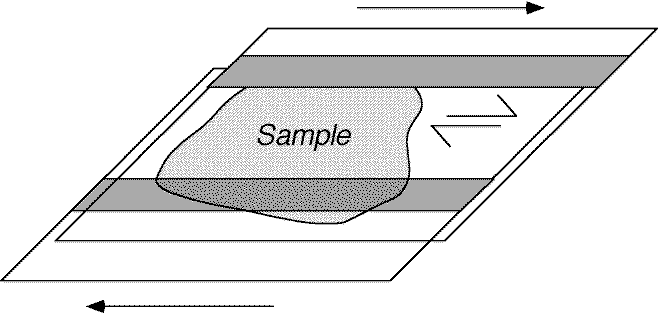
2) Mechanical experiments in analogue materials.
Real rocks are generally very hard to deform at room T & P, however by examining the behaviour of non-geological materials we can learn a lot about the mechanics of deformation and microstructure formation. We will look at four small excerpts from some experiments performed by Youngdo Park, Win Means, and Jin-Han Ree from the State University of New York at Albany, using an organic chemical called Octachloropropane (C3Cl8). All the experiments were performed by shearing the material between two glass plates, with thin frosted strips acting as grips as shown on the next figure...

A) Movie 01- Fracture and flow of polycrystalline OCP Fracturing and frictional sliding are often neglected deformation mechanisms in rocks that also show crystalline plasticity.

Estimate the shear strain shown in this movie, and guesstimate the amount of shearing taken up by the sliding plane about 20% up the image.

B) Movie 02 Plasticity and fracture in polycrystalline OCP
These two movies show fracturing and sliding behaviour in OCP at the same time as twinning, and at the same time as intra-crystalline plasticity. The final frame of the movie shows the microstructure in plane light, to highlight the fractures. Describe the deformation mechanisms evident in the two movies, and explain how they allow shape change in the aggregate.
C) Undulose Extinction
Play the movie below. In this movie we can see the development of undulose extinction in two grains A & B. Notice the contrast in behaviour between the two grains, with one showing very sharp variations within the grain in orientation (and hence extinction), and the other showing only gradual changes. What deformation mechanisms can you see evidence for in this movie.

Movie 03 Undulose extinction in polycrystalline OCP